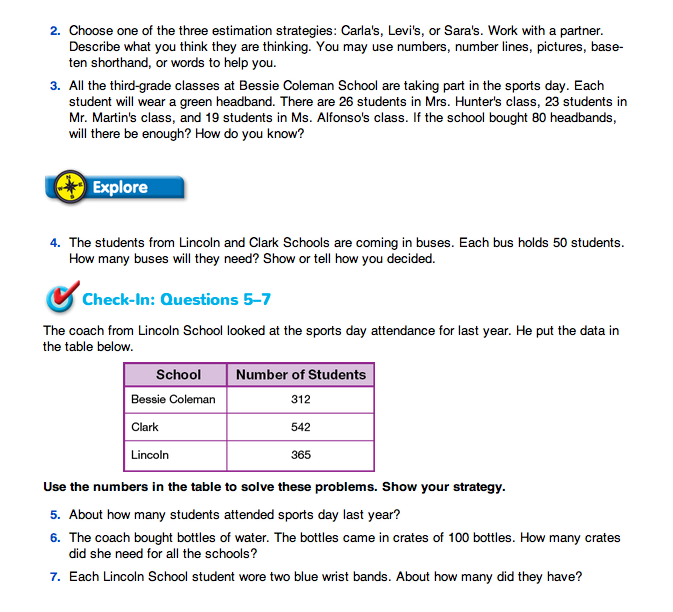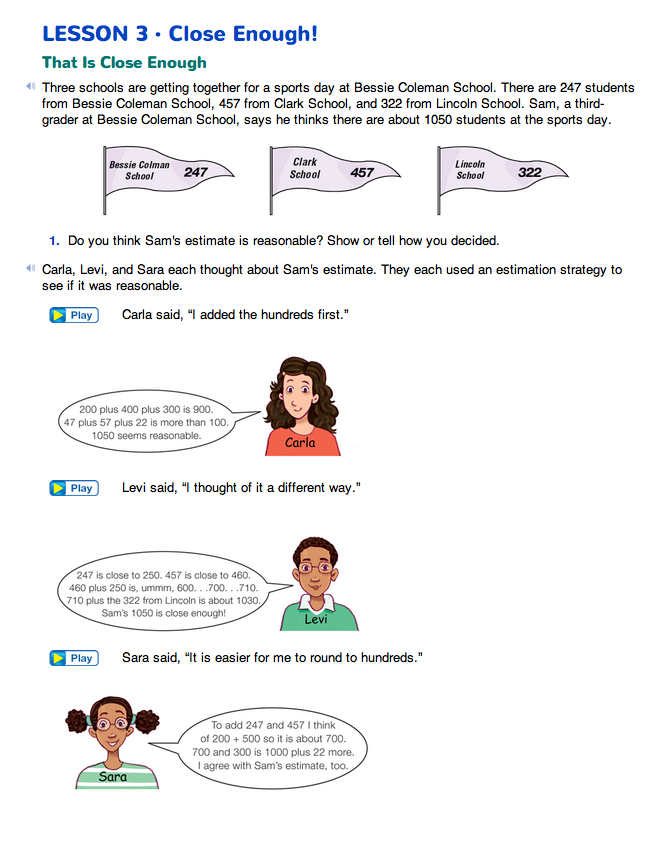Close Enough!
Est. Class Sessions: 3Developing the Lesson
Part 2. Strategies for Computational Estimation
Find Convenient Numbers. Explain that rounding is one strategy that can be used to find a reasonable estimate when an exact number is not needed. When rounding to the nearest ten or hundred, the numbers that you round to are sometimes called benchmark numbers. Benchmark numbers can also be called convenient numbers. Convenient numbers are numbers that are easy to use when you solve problems using mental math.
Ask:
Display the number 123.
Ask:
Help students think about other strategies to find convenient numbers.
Ask them to again think about the number 123 and ask:
Use Convenient Numbers to Estimate Sums and Differences. Ask students to work with a partner to read the vignette and complete Question 1 on the Close Enough! pages in the Student Guide. After students have had time to work together, ask them to share their thinking.
For Question 1, students may round all of the numbers to the nearest hundred, so that the estimate is 200 + 500 + 300 or 1000. This is a reasonable estimate, since rounding 247 down and 457 up will make for a fairly good estimate. It is important for students to look back at their estimates in this way to see if the convenient numbers they used balance out.
Students might prefer front-end estimation in which only the left-most digits are used to estimate. One advantage to this method is that students can visualize the largest base-ten pieces in each number. For example, the numbers in the vignette can be seen as 200 + 400 + 300 = 900 (2 flats + 4 flats + 3 flats = 9 flats). However, if students think again about the numbers in the problem (and their representations with base-ten pieces), they will realize that their estimate is low since they did not take into account any of the tens and ones (skinnies and bits) and they might want to revise their estimate upward.
Have students work with a partner or in small groups to read the estimation strategies used by Carla, Levi, and Sara in the Student Guide and complete Question 2. Ask students to choose one of the three strategies and prepare a brief presentation using base-ten shorthand (or pieces), number lines, pictures, numbers, or words that will clearly explain the strategy they chose. For example, for Carla's strategy, students may show the numbers using base-ten shorthand and count the flats to explain how Carla knew “200 + 300 + 400 is 900.” Then they can combine the remaining pieces and show that they will make more than a flat or “more than 100” to make the answer more than 1000, so Sam's estimate of 1050 students is reasonable. Encourage students to ask questions of the presenters if the presentation is not clear enough for others to understand.
After students have finished their presentations, ask:
Ask students to share any other estimation strategies that could be used.
Discuss Strategies for Finding Convenient Numbers. Ask students to work in pairs to solve Questions 3–4 on the Close Enough! pages in the Student Guide. As students work, encourage them to round appropriately and choose friendly numbers that will make the computation easy to compute mentally but produce a reasonable estimate.
Use prompts similar to the following:
Discuss student solutions for Question 4. To solve this problem students may choose to round both 457 and 322 to the nearest ten. They can then add 460 + 320 = 780, and use this number to decide how many buses. Since each bus holds 50 students, 16 buses are needed to transport students from Clark School and Lincoln School. Students might also round both 457 and 322 to the nearest hundred and then add 500 + 300 = 800 to decide the number of buses (16) that are needed. A third strategy would be to decide how many buses Clark School needs (10) and then how many Lincoln School needs (7) and then add the buses for each for a total of 17 buses needed.
Assign Check-In: Questions 5–7 in the Student Guide for students to complete independently. Remind students to use the strategies they have learned to find convenient numbers that will help them solve each problem.
















